Inside a Kiwi Nursery
by Helen Cordery
The kiwi is unique to Aotearoa New Zealand. This quirky bird – flightless, nocturnal and with the world’s smallest beak (technically) – is loved so much that New Zealanders are often called ‘kiwis’. The kiwi bird is also threatened, with only about 68,000 left in the wild. The Department of Conservation estimates that 20 are killed every week due to introduced predators and habitat loss. Pūkaha has been breeding kiwi since 1978, and today takes part in the national Operation Nest Egg and Kiwis for Kiwi projects. In this blog, we take you inside our Kiwi Nursery to show you where the magic happens …
Using telemetry
Some of our wild male kiwi have a small transmitter attached to their leg. We monitor them because it lets us know if something is wrong as well as when eggs are laid.
When we go out into the forest, we track these kiwi using telemetry, which transmits small pulses. Different pulses mean different things: 48 indicates the bird is incubating an egg (the male) while 80 can mean that the bird is either dead or has dropped its transmitter.
Retrieving the egg
Our Head Ranger, Jess Flamy, takes the telemetry readings and uses a computer programme to determine how long the kiwi has been incubating its egg. At day 60, she will go out to collect the egg. This is a highly specialised job that required training with the Department of Conservation. We do day retrievals so the kiwi is usually asleep.
Once Jess has the egg, she ‘candles’ it using a torch to check its position so that she can place it in the incubator the right way round. It’s placed in a sock and then into a chilly bin lined with foam before being taken to the Kiwi Nursery at Pūkaha. Sometimes this is quite a walk away – sometimes it takes 6 hours to reach a kiwi burrow!
At the Kiwi Nursery
The first thing we do is give the egg a wash and then candle it again, this time in a dark room. We are looking to see the veins so we know the embryo is alive inside. We then do the ‘rock’ test on the bench; if it doesn’t, Jess will try warming it up for a bit in the incubator first. We don’t want a rotten egg – they are known to explode in the incubator!
We draw a line over the air cell, the area where the kiwi will eventually poke its beak through. We need to monitor this because as time goes on, this air cell will expand and drop; if it doesn’t, we need to try different techniques to help it along.
We keep the kiwi snug in an incubator until we notice any progress. The kiwi will begin to ‘internally pip’ its beak through the membrane of the air cell. After several days, the kiwi will start externally pipping by breaking the shell.
The kiwi hatches
Unlike other birds, the kiwi does not have a special egg tooth to help it break free of the shell. Instead, it has to rely on its strong legs and it’s pretty exhausting stuff! Once the kiwi has pipped its shell open for the first time, it will take its first breath of fresh air … before falling asleep!
When it wakes up, it is time to keep pushing! The kiwi will spend up to three days pushing and kicking its way out.
Kiwi meets the world
The kiwi chick has a hard time standing at first because it has ingested so much egg yolk. This is something pretty unique to kiwi and means that they don’t need to eat or drink anything for the next 6 days or so. The yolk Works in much the same way as the human placenta – in fact, sometimes Jess even has to cut the ‘cord’ that connects the kiwi with the yolk!
In the wild, it will keep warm under dad. At Pūkaha, we clean the bird and weight it before placing it in a nice warm incubator to get dry.
Later the kiwi is moved into a ‘brooder’ where it learns how to eat. It weighs about 350 grams on hatching – all that yolk – but it will quickly lose 20% of that. Our work next is to help it regain that body weight.
Into the outdoors
As soon as the chick regains its hatch weight, it graduates to our pre-release enclosure. This is a fully-fenced pen where it learns how to forage for food like berries, bugs and moths. We weigh it several times a week to check how its growing. Once it reaches 1.2kg it is time to release the kiwi into the wild. We release all our kiwi into the Pūkaha reserve, meaning that our 942-hectares has plenty of wild, happy kiwi running around in it!
Kiwis for Kiwi
Pūkaha is proudly part of the national Kiwis for Kiwi project. We signed up in 2017 to help increase national kiwi populations by 2%. As part of this agreement, we receive eggs from the Taranaki and Hawkes Bay regions, which we then incubate and raise until the birds regain their hatch weight. After that, they are sent back to their respective regions to enter a kiwi creche or the wild.
How you can help
Everyone can join the cause to help our native wildlife! Pūkaha gratefully accepts donations (go here for more information) or you can sign up as a member. All our proceeds – from the Visitor Centre gift shop, the Kākā Café right through to our wedding packages – ultimately end up in our wildlife programmes, either as part of our forest restoration work or our captive breeding. We hope to see you soon at Pūkaha!
